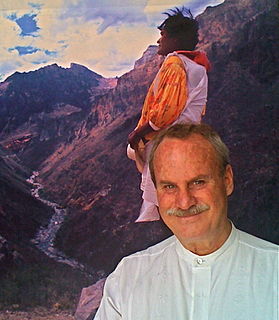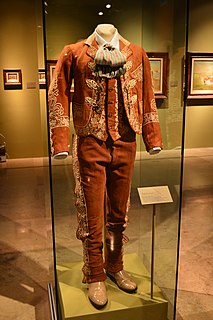Related Research Articles

Tejanos are the Hispanic residents of the state of Texas who are culturally descended from the original Spanish-speaking settlers of Tejas, Coahuila, and other northern Mexican states. They may be variously of Spaniards, Criollo Spaniard, Mestizo, or indigenous origin.

The Southwestern United States, also known as the American Southwest or simply the Southwest, is a geographic and cultural region of the United States that generally includes Arizona, New Mexico, and adjacent portions of California, Colorado, Nevada, Oklahoma, Texas, and Utah. The largest cities by metropolitan area are Phoenix, Las Vegas, El Paso, Albuquerque, and Tucson. Prior to 1848, in the historical region of Santa Fe de Nuevo México as well as parts of Alta California and Coahuila y Tejas, settlement was almost non-existent outside of Nuevo México's Pueblos and Spanish or Mexican municipalities. Much of area had been a part of New Spain and Mexico until the United States acquired the area through the Treaty of Guadalupe Hidalgo in 1848 and the smaller Gadsden Purchase in 1854.

Las Posadas is a novenario. It is celebrated chiefly in Latin America, Mexico, Guatemala, Cuba, Spain, and by Hispanics in the United States. It is typically celebrated each year between December 16 and December 24. Latin American countries have continued to celebrate the holiday, with very few changes to the tradition.

Mariachi is a genre of regional Mexican music that dates back to at least the 18th century, evolving over time in the countryside of various regions of western Mexico. The usual mariachi group today consists of as many as eight violins, two trumpets and at least one guitar, including a high-pitched vihuela and an acoustic bass guitar called a guitarrón, and all players taking turns singing lead and doing backup vocals.

A charro is a traditional horseman from Mexico, originating in the central regions primarily in the states of Jalisco, Michoacán, Nayarit, Colima, Zacatecas, Durango, Chihuahua, Aguascalientes, Querétaro, and Guanajuato. The vaquero and ranchero are similar to the charro but different in culture, etiquette, mannerism, clothing, tradition and social status. The inhabitants of southern Salamanca, the province of Spain, are also called "charros". Among these, the inhabitants of the regions of Alba de Tormes, Vitigudino, Ciudad Rodrigo and Ledesma are specifically known for their traditional "ganadería" heritage and colorful glitzy clothing.

The charreada or charrería is a competitive event similar to rodeo and was developed from animal husbandry practices used on the haciendas of old Mexico. The sport has been described as "living history," or as an art form drawn from the demands of working life. In 2016, charrería was inscribed in the Representative List of the Intangible Cultural Heritage of Humanity by UNESCO.

Isidore the Farm Labourer, also known as Isidore the Farmer, was a Spanish farmworker known for his piety toward the poor and animals. He is the Catholic patron saint of farmers and of Madrid, El Gobernador, Jalisco and of La Ceiba, Honduras. His feast day is celebrated on May 15.

The culture of San Antonio reflects the history and culture of one of the state's oldest and largest cities straddling the regional and cultural divide between South and Central Texas. Historically, San Antonio culture comes from a blend of Central Texas (Southern) and South Texas (Southwestern) culture. Founded as a Spanish outpost and the first civil settlement in Texas, San Antonio is heavily influenced by Mexican American culture due to Texas formerly being part of Mexico and, previously, the Spanish Empire. The city also has significant German, Anglo, and African American cultural influences. San Antonio offers a host of cultural institutions, events, restaurants and nightlife in South Texas for both residents and visitors alike.

Presidio San Agustín del Tucsón was a presidio located within Tucson, Arizona. The original fortress was built by Spanish soldiers during the 18th century and was the founding structure of what became the city of Tucson. After the American arrival in 1856, the original walls were dismantled, with the last section torn down in 1918. A reconstruction of the northeast corner of the fort was completed in 2007 following an archaeological excavation that located the fort's northeast tower.
Charro Days, also known as Charro Days Fiesta or Charro Days Festival, is a two-nation fiesta and an annual four-day pre-Lenten celebration held in Brownsville, Texas, United States in cooperation with Matamoros, Tamaulipas, Mexico. The grito—a joyous Mexican shout—opens the festivities every year. This festival is a shared heritage celebration between the two border cities of Brownsville, Texas and Matamoros, Tamaulipas. The Charro Days festivals usually have about 50,000 attendees each year. This celebration includes the Sombrero Festival as well as a parade that goes down Elizabeth St. through Historic Downtown Brownsville, TX.

Folk dance of Mexico, commonly known as baile folklorico, is a term used to collectively describe traditional Mexican dances. Ballet folklórico is not just one type of dance, it encompasses each region's traditional dance that has been influenced by their local folklore and has been entwined with ballet characteristics to be made into a theatrical production. Each dance represents a different region in Mexico illustrated through their different zapateado, footwork, having differing stomps or heel toe points, and choreography that imitates animals from their region such as horses, iguanas, and vultures.

George O. Jackson Jr., is a photographer who documented the seasonal religious festivals of the indigenous peoples of Mexico. The photography project, called The Essence of Mexico, was conducted from 1990 through 2001 and resulted in more than 75,000 color images of the traditional rites and ceremonies of more than 60 different indigenous cultural groups. The original images now belong to the University of Texas in Austin, where they are part of the Benson Collection of Latin American Art. The collection is shared with the San Antonio Museum of Art's Nelson A. Rockefeller Center for Latin American Art in San Antonio, Texas.
Numerous events and festivals are held annually in Metro Manila. They include:

Emily Cranz is an American-born Mexican actress, singer, and dancer.
Carnival in Mexico is celebrated by about 225 communities in various ways, with the largest and best known modern celebrations occurring in Mazatlán and the city of Veracruz.

Christmas in Mexico is observed from December 12 to January 6, with one additional celebration on February 2. Traditional decorations displayed on this holiday include nativity scenes, poinsettias, and Christmas trees. The season begins with celebrations related to the Virgin of Guadalupe, the Patroness of Mexico, followed by traditions such as Las Posadas and Pastorelas.

A charro or charra outfit or suit is a style of dress originating in Mexico and based on the clothing of a type of horseman, the charro. The style of clothing is often associated with charreada participants, mariachi music performers, Mexican history, and celebration in festivals. The charro outfit is one that is associated with Mexico around the world. It is seen as a national emblem and a way to express personal pride in Mexican heritage. Charro outfits can be worn by men or women and have various levels of formality from work-wear to very expensive formal attire. The outfits consist of tight, decorated pants or a long skirt, short jackets, silk ties and are often worn with a wide-brimmed sombrero and other accessories as appropriate.
Tortugas, New Mexico or Tortugas Pueblo is a community in Doña Ana County, New Mexico, just outside of Las Cruces, New Mexico.
A Mexican American is a resident of the United States who is of Mexican descent. Mexican American-related topics include the following:
References
- ↑ Fiesta Mexicana Archived 2004-11-11 at the Wayback Machine
- ↑ "Frontier Fiesta". University of Houston Digital Library. Retrieved 2012-02-19.